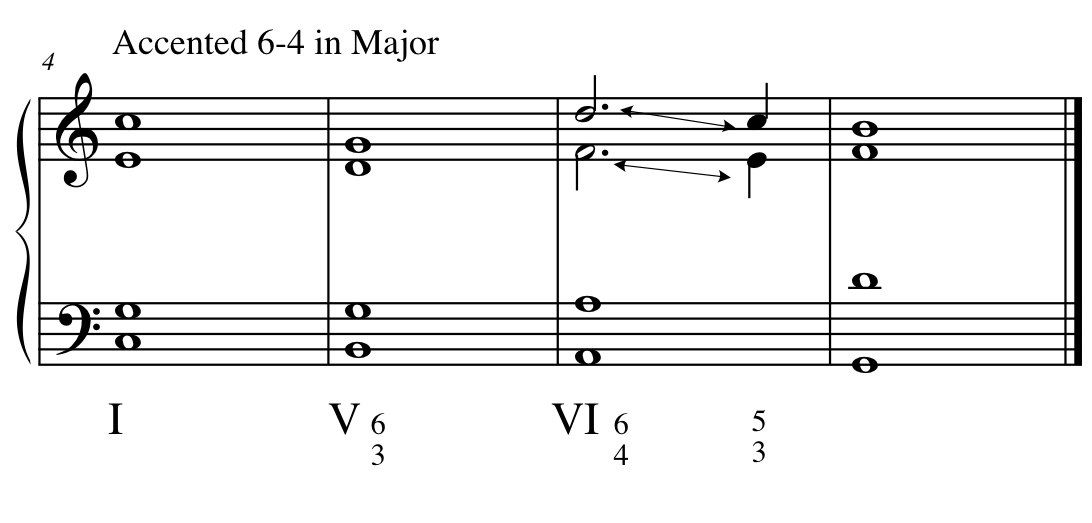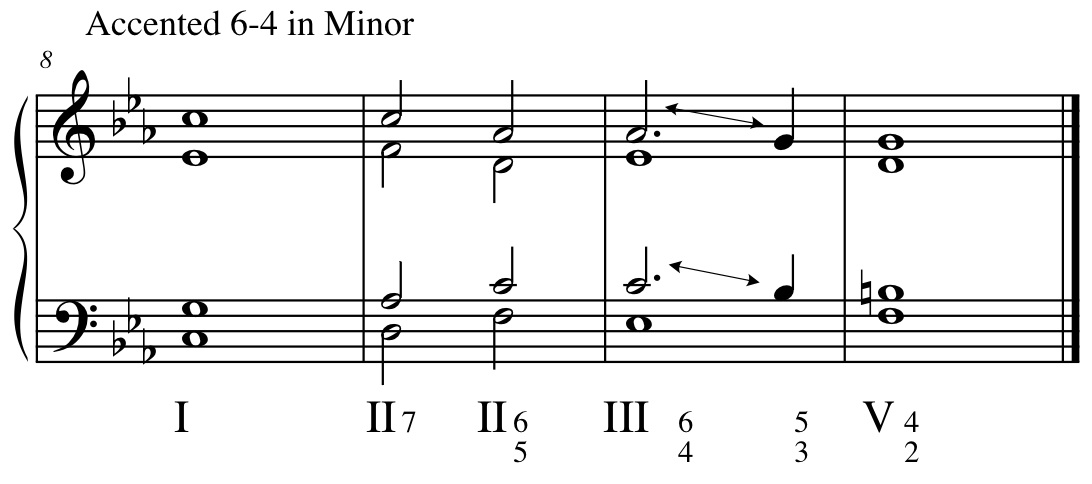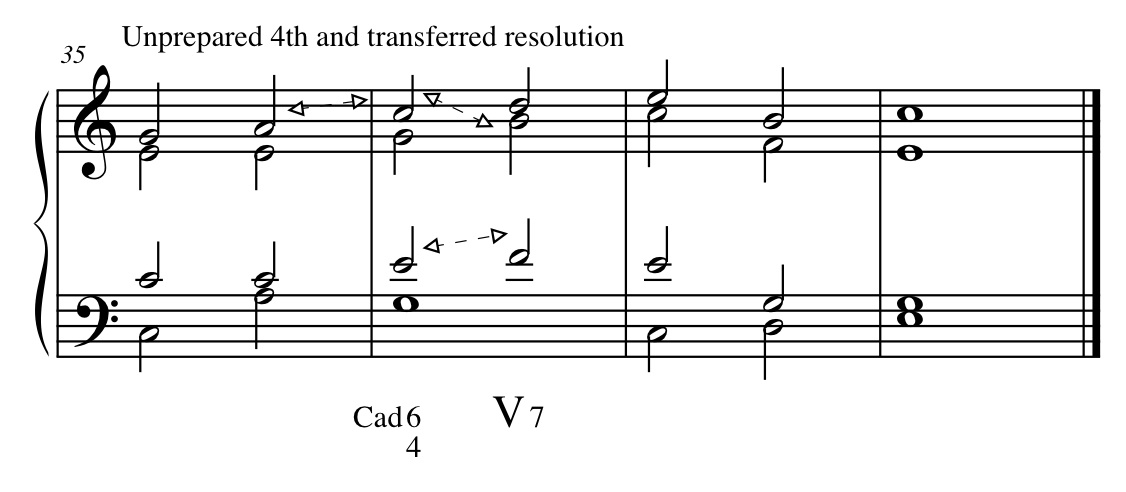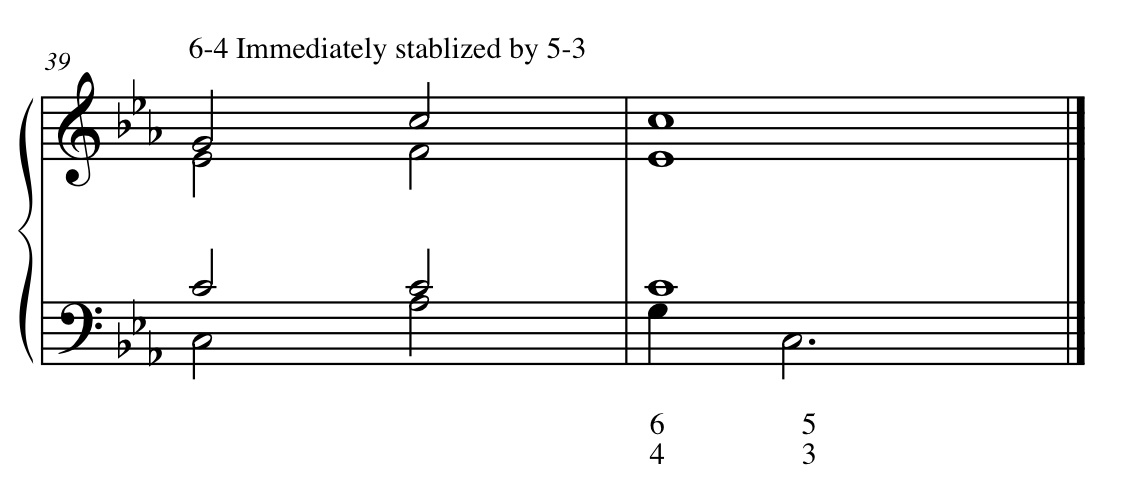Homework: Workbook Chapter 19 p173 #1 p175#1, p181#7,8,9
Homework: Workbook Ed 4 Chapter 16: pg 184 a,c,e,f,h, 185#2, 190#3, 194#9,10
1. The double nature of the 6-4 Chord
a. So far we have seen the 6-4 chord act as both a dissonant and consonant chord. The duality of the 6-4 chord arises from the function of the interval of a P4 contained in every 6-4 chord. When the interval presents itself as a passing or neighboring tone to a clearly consonant sonority, the P4 takes on a dissonant character.
b. When the P4 forms part of an unfolding sonority, as is the case in an arpeggiation, the P$ takes on a consonant character.

Dissonant 6-4 Chords
2. Three Main Types
a. Although there are numerous uses of of the 6-4 chord, most can be categorized as 1) Accented 6-4s 2) Neighboring 6-4s and 3) Passing 6-4s
3. Accented 6-4 Chords.
a. A quick review of the Cadential 6-4 shows how the chord delays the arrival of the expected dominant V. The 6-4 above the 5th scale degree is heard not as a I chord but more as accented dissonant chord that resolves to V. We have said, in fact, that the chords syntax acts more as a delayed arrival of V than the actual I which it spells.
b. When a dissonant 6-4 chord falls on a strong or accented beat and delays the arrival of an expected melodic or harmonic event, we call that chord an Accented 6-4. In essence, the Accented 6-4 is exactly like a Cadential 6-4 just not part of a cadence. That is, the Accented 6-4 may occur within any proper syntax. Like the Cadential 6-4, it will take on the characteristic of its chord of resolution and should be labeld as such.
c. Voice leading follows the same guidelines as that for the Cad6-4. Double the root in 4 voices to avoid ¶s
d. A word of caution: Try to avoid resolving an Accented 6-4 to a diminished 5-3.


4. Neighboring 6-4 Chords
a. When a 6-4 chord arises from the movement of upper voices to neighbor tones, we get a Neighboring 6-4
b. Like the Cadential 6-4 and the Accented 6-4 the Neighbor 6-4 will typically double the root and resolve the other voices down.
5. Passing 6-4 Chords (above a moving bass)
a. Just as 6-3 chords can be used between a 5-3 chord and the same chord in 6-3 position (visa versa), so too can a 6-4 be used between a 5-3 chord and the same chord in 6-3 position.
b. The passing 6-4 can also expand 7th chords.
c. Passing 6-4 can expand substitution chords like IV6-II6 (instead of IV5)

6. Passing 6-4 above a sustained bass
a. Like the Syncope, a 6-4 chord may appear as a result of movement above a sustained bass. Similar to the passing 6-3, the passing 6-4 will often connect a root position 5-3 to a 6-3 with a bass a step above or below that of the 6-4.
insert 195a+b


7. Elaborated 64 Chords above a sustained bass
a. H&VL simply states that 64s can be elaborated.
8. 64 as incomplete neighbors.
a. Sometimes we see 64 chords arise over a sustained bass but not continuing to a step wise bass progression. This kind of incomplete neighbor 64 is most common within syntax where the 64 would otherwise be represented by some other inversion of the same chord

Special Treatment of Cadential 64
9. Unprepared 4ths and Transferred Resolutions
a. Sometimes, especially in instrumental music, we see the dissonant 4th of the cad64 appear not prepared as a suspension or accented passing tone but rather as a leap
b. Sometimes, especially in instrumental music we see the resolution of the dissonant 4th transferred to another voice to allow for melodic or motivic considerations

10. Expanding the Cad64
a. The tension of a Cad64 can be enhanced by expanding it through an arpeggio before resolving it.
11. Interpolation between a 64 and its resolution
a. Sometimes a neighbor chord to the 64 will be interpolated between the 64 and its resolution.
12. Metrically the Cad64
a. We know that the Cad64 tends to occur on a relatively strong beat. However I have been "soft" on this rule (as I am about harmonic metrical placement in general). Here, H&VL simply states that sometimes we see the Cad64 happen on a relatively weak beat.

Please note: The above example should read "the resolution will always arrive at a chord a third HIGHER than the original 6-3" (the text embedded in the jpg will be updated soon)
Consonant 64 Chords
13. The Arpeggio 64
a. As stated in 1b above, when a 64 appears as an unfolding sonority within an apreggio, we do not hear it as dissonant.
14. The Consonant 64-53
a. Sometimes a 64 will occur in place of a 53 and then stablized imeediately by the 53

15. The Oscillating 64 (Waltz/March)
a. In this kind of figure the ear is really led to an arpeggiation of the fundamental underlying chord rather than an interpretation of each apparent chord.

Some Special Cases
16. 64 by voice exchange.
a. If you look very closely at what H&VL is saying, this is really nothing more than a restatement of the function of a passing 64 between a chord in 6-3 and the same chord in 5-3 position (see 5a above)
17. 64 chords with augmented 4ths (Vii64)
a. The functional harmony of a 64 is based on the P4 being dissonant and resolving. When a 64 chord arises with an Aug 4th, such as the Vii64, the function of that harmony is changed. Here, as in many cases, H&VL suggests that such a harmony, especially when expressed in 3 voices, be considered in other contexts. That is, a Vii64 may well be considered a V42 without the ^5. Although this statement is made specifically to this type of 64, when we do harmonic analysis, we do not see the complete chord. In such circumstances we must focus on what our ear "really hears" and often will have to reinterpret a litteral spelling of that chord.
16. Dissonant or Consonant V or I?
a. H&VL ends the chapter with a restatement that the function of a 64 is based primarily on its context. As we have seen, a great expectation of I, arriving at a I64 (as is the case with an arpeggiated I or the Consonant 64-53 (13 +14 above) will lead the ear to hear the 64 as a I chord not as a V. As with all harmonic analysis, let your ear be the judge of your minds deliberations!
|

